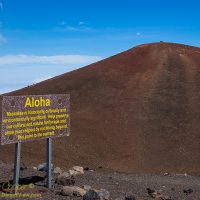The sign is at the start of the trail.

How many people even pause when considering the message on the sign? The trail and the desire to stand atop the real summit of the mountain is substantial. As we pass the trail head and sign each day I usually see several people walking to or standing atop the summit.
Aloha
Maunakea is historically, culturally, and environmentally significant. Help preserve our cultural and natural landscape and show your respect by not hiking beyond this point to the summit.
I have walked this short trail to the summit several times over the years, though not since the sign appeared. There are no particularly sensitive archaeological sites at the summit. This is in contrast to Lake Waiau, which is ringed with shrines and offerings, is just as sacred, and has no such sign to deter the curious from taking the trail.
Personally I am troubled by this sign. Placing such a sign could very well be counter productive. People are going to ignore it, walking right past it to the summit of Mauna Kea. It simply teaches people to ignore boundaries that could protect sensitive sites.
The summit is public land, belonging to the people of Hawaiʻi. I have trouble with the idea that it should be accessible only to a few on the pretense of religious or cultural heritage. Certainly some might view the summit with less than ideal respect for a special place, simply a pile of rock to be conquered. I suspect most see the summit as more than that, a symbol, a place to sit and think about the world.
I am not a religious person, but still, there are places where I find myself stopping and taking a moment to contemplate our world. The summit is one of these places, a focal point of culture, history, and perhaps the future.
Update Oct 4th: Several folks have commented that a sign educating people about the significance of the place, asking them to be respectful, and asking them to stay within the marked trail would be far more appropriate and productive in terms of protecting the site. I have to agree.
Update Oct 5th: I have posted a follow up article. The response to this article has been impressive, with a lot of heartfelt comments. How we view and respect true summit of Mauna Kea is obviously a subject very important to may people.


“Personally I am troubled by this sign. Placing such a sign could very well be counter productive. People are going to ignore it, walking right past it to the summit of Mauna Kea. It simply teaches people to ignore boundaries that could protect sensitive sites.”
I absolutely agree with this. It seems that nearly every hike worth doing in Hawaii is prohibited. It seems that the only permissible and interesting hikes are boardwalks. I worry that I will someday end up in cuffs after disregarding a no-hiking sign at the beginning of a trail, simply because I have been habituated to do that 100% of the time.
Hawaii Volcanoes NP discourages people from going to the 61G lava flow. Some of their statements (especially before it reached the ocean) made it sound like visiting it was illegal. Visiting the lava anywhere else on the island is definitely illegal, but people do it all the time, and there is little enforcement. The White Road Hike, one of the most scenic hikes on this island, is prohibited. Hiking anywhere in Waipio Valley other than the beach will result in people yelling at you, even if you are still on the public roads. The Haiku Stairs on Oahu is another example of an amazing but illegal hike.
I could keep listing hikes that you’re not really supposed to do, but there is little/no enforcement. Others have noticed the rarity of trails that are both legal and interesting in Hawaii–see this April 1 news release spoof: http://www.explorationhawaii.com/2015/03/23/hawaii-to-shut-down-all-hiking-trails-cites-entire-state-as-being-on-private-land/
What I’m saying is that Hawaii should stop putting no-hiking signs everywhere. Those trails that are legitimately hazardous or have delicate ecosystems in need of protection should be closed off, and the closures should ACTUALLY be enforced. By habituating everyone to ignore no-hiking signs, everyone loses. If the summit of Mauna Kea is delicate and humans walking on it would damage it, then it should be closed off, and rangers should enforce the closure. If it is not, then people should be allowed to walk to it. A sign stating the cultural significance and encouraging respect is completely reasonable.